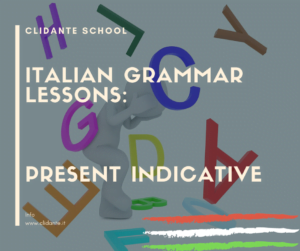When you start studying Italian you will learn present tenses and in most cases you will start with present indicative in Italian. Using this tense with regular verbs is quite simple, but it can become more complex when you have to use irregular verbs. Discover how to use the present indicative in Italian.
In this Italian grammar lesson we are going to discover how to use the present indicative in italian. Clidante‘s goal is to help students learn the basis of Italian language in a short time and then become experts.
How to use the present indicative in Italian
The present indicative in Italian is the tense which can be used when you want to describe something that happens in the present. It is usually the first tense that students are taught, because the present indicative will be the most used tense at the beginning of the learning path of Italian language.
As for the word indicative, this represents that this tense can be used to express questions, statements and opinions. You should study this tense and use it together with other Italian tenses, for example you could have a look at our grammar lesson about the gerund in Italian.
How to make the present indicative in Italian
Let’s learn how to make the present indicative in Italian, so that we can be ready to use this tense when it will be necessary. First of all, we have to remove the endings –are, -ere, -ire of Italian verbs, then we have to choose the right ending according to the person we need to use.
This is the present indicative of the verb giocare (to play):
- Io gioco
- Tu giochi
- Egli gioca
- Noi giochiamo
- Voi giocate
- Essi giocano
This is the present indicative of the verb scrivere (to write):
- Io scrivo
- Tu scrivi
- Egli scrive
- Noi scriviamo
- Voi scrivete
- Essi scrivono
This is the present indicative of the verb dormire (to sleep)
- Io dormo
- Tu dormi
- Egli dorme
- Noi dormiamo
- Voi dormite
- Essi dormono
As you can see, the present indicative in Italian is quite simple, the endings are always the same. If you want to reduce learning times, read our guide about how to learn Italian verbs quickly.
You can study Italian present indicative during Clidante’s Italian courses. This is the enrollment form you can fill to become a student of Clidante and to start learning the grammar of this language.
